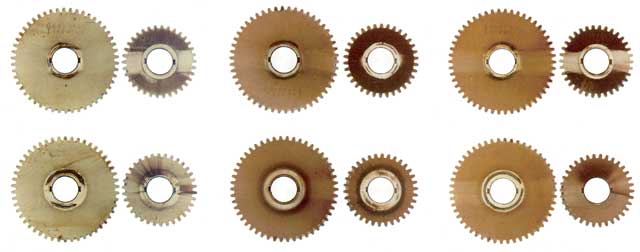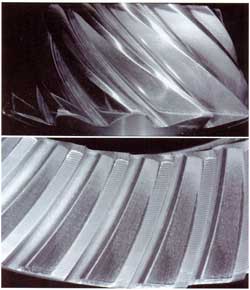AMSOIL Synthetic Gear Lube Outperforms
Valvoline
Gear Lube
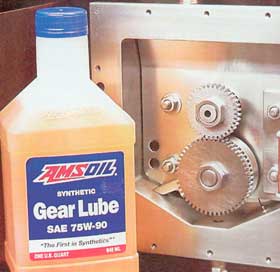 High
quality gear oils must lubricate, cool and protect geared systems.
They must also carry damaging wear debris away from contact zones
and muffle the sound of gear operation. Commonly used in
differential gears and standard transmission applications in
commercial and passenger vehicles, as well as a variety of
industrial machinery, gear oils must offer extreme temperature and
pressure protection in order to prevent wear, pitting, spalling,
scoring, scuffing and other types of damage that result in equipment
failure and downtime. Protection against oxidation, thermal
degradation, rust, copper corrosion and foaming is also important.
High
quality gear oils must lubricate, cool and protect geared systems.
They must also carry damaging wear debris away from contact zones
and muffle the sound of gear operation. Commonly used in
differential gears and standard transmission applications in
commercial and passenger vehicles, as well as a variety of
industrial machinery, gear oils must offer extreme temperature and
pressure protection in order to prevent wear, pitting, spalling,
scoring, scuffing and other types of damage that result in equipment
failure and downtime. Protection against oxidation, thermal
degradation, rust, copper corrosion and foaming is also important.
AMSOIL submitted its 75W-90 Synthetic Gear Lube (AGR) and Valvoline 75W-90 Gear Lube to an independent laboratory for quality comparison tests. The gear lubes were tested according to ASTM testing procedures in several critical performance areas, including oxidation resistance, viscosity retention and cold temperature fluidity. Oxidation resistance was measured using the L-60-1 Thermal Oxidation Stability Test, viscosity retention was measured using the KRL Shear Stability Test and cold temperature fluidity was measured using the Brookfield Viscosity Test. Additional load carrying, wear, extreme pressure and scoring protection tests were performed exclusively on AMSOIL 75W-90 Synthetic Gear Lube using the L-37 High Torque Axle Test and the L-42 High Speed Axle Test.
L-60-1 Thermal Oxidation Stability Test
Test Conditions
The L-60-1 Thermal Oxidation Stability Test measures a lubricant's
rate of deterioration under severe oxidation conditions. A measured
sample of test lubricant is placed in a special gear case with two
spur gears and a copper catalyst strip. The gears are driven at
1,725 rpm at 163°C for a 50-hour duration, while air is bubbled
through the sample.
Viscosity increase, deposits not soluble in pentane or toluene, carbon varnish and sludge deposits are measured upon test completion. Test specifications are listed below.
|
L-60-1 Thermal Oxidation
Stability Test Specifications
|
|||
| API GL-5 | API MT-1/SAE J-2360/ MIL-PRF-2105E/Mack GO-J |
Mack GO-J+ | |
| Test Conditions | 50 hours @ 163°C | 50 hours @ 163°C | 100 hours @ 163°C |
| Viscosity Rise, % | 100 Max. | 100 Max. | 100 Max. |
| Pentane Insolubles, % | 3 Max. | 3 Max. | 3 Max. |
| Toluene Insolubles, % | 2 Max. | 2 Max. | 2 Max. |
| Carbon Varnish, rating | Not required | 7.5 Min. | 7.5 Min. |
| Sludge, rating | Not required | 9.4 Min. | 9.4 Min. |
|
L-60-1 Thermal Oxidation
Stability Test Results
|
|||
| AMSOIL Synthetic 75W-90 |
Valvoline 75W-90 |
Valvoline 75W-90 |
|
| Test Conditions | 100 hours @ 163°C | 50 hours @ 163°C | 100 hours @ 163°C |
| Viscosity Rise, % | 25.17 | 17.50 | 38.50 |
| Pentane Insolubles, % | 0.20 | 0.87 | 1.17 |
| Toluene Insolubles, % | 0.13 | 1.11 | 0.99 |
| Carbon Varnish, rating | 8.0 | 7.2 | 5.9 |
| Sludge, rating | 9.5 | 9.4 | 9.4 |
Test Results
Because AMSOIL 75W-90 Synthetic Gear Lube is a premium lubricant
designed for extended drain service, the test was allowed to
continue for 100 straight hours, double the standard test length.
The Valvoline 75W-90 was run at both the standard 50-hour test
length and the double 100-hour test length. Test results indicate
AMSOIL 75W-90 Synthetic Gear Lube outperformed Valvoline at both
test lengths.
Even at double the standard test length, AMSOIL 75W-90 scored almost four times better than industry test specifications in the area of viscosity increase, while also greatly exceeding specifications in all areas of the test.
The photographs below show the superior deposit-control characteristics of AMSOIL 75W-90 Synthetic Gear Lube.
|
L-60-1 Thermal Oxidation Stability Test Results
|
|||
|
|||
|
|
|||
| Even after enduring a double-length, 100-hour L-60-1 Thermal Oxidation Stability Test, AMSOIL 75W-90 Synthetic Gear Lube produced significantly fewer deposits than the Valvoline 75W-90 run at a standard, 50-hour test. |
KRL Shear Stability Test
Test Conditions
It is essential that high-quality gear lubes resist shear to ensure
adequate oil film thickness and protection against friction and
wear. The KRL Shear Stability Test is used to determine the
mechanical shear stability of lubricants containing polymer.
Mandatory under the SAE J-306 gear oil standard, the KRL Shear
Stability Test makes use of a taper roller bearing in order to shear
the test fluid and determine the permanent drop in viscosity caused
by the mechanical stress under practical conditions. Under the
specifications of SAE J- 306, the measured viscosity at 100°C (212°F)
of an SAE 90 gear oil must exceed 13.5 cSt after 20 hours of
testing.
Test Results
AMSOIL 75W-90 Synthetic Gear Lube easily exceeded SAE J-306
specifications following the 20-hour test length and was allowed to
continue for a total of 192 straight hours, almost 10 times longer
than the standard test length. Even after this extended test, AMSOIL
75W-90 lost only 0.40 percent of its original viscosity, making it
99.6 percent shear stable.
Valvoline 75W-90 Gear Lube, on the other hand,
failed the test during the initial 20-hour testing period, losing 14
percent of its original viscosity.
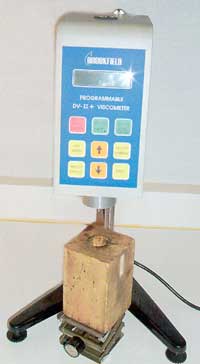 Brookfield Viscosity Test
Brookfield Viscosity Test
Test Conditions
The Brookfield Viscosity Test (ASTM 0-2983) is used to determine the
internal fluid-friction of a lubricant during cold temperature
operation. The lubricant sample is chilled in a -40°C (-40° F) air
bath for 16 hours, and a Brookfield viscometer determines the torque
required to shear the lubricant. The lower the cold temperature
viscosity (measured in centipoise), the better the cold temperature
protection. ASTM specifications dictate that 75W-90 gear oils
measure less than 150,000 cP at test completion.
Test Results
AMSOIL 75W-90 Synthetic Gear Lube easily passed the Brookfield
Viscosity Test, measuring 88,000 cP at test completion, 42 percent
less than test limits. The superior cold temperature properties of
AMSOIL 75W-90 Synthetic Gear Lube ensure quicker oil flow, enhanced
component protection and improved fuel efficiency.
Many conventional lubricants fail to pass the Brookfield Viscosity Test due to the paraffinic (wax) content in their base oils. Valvoline Gear Lube passed the test at 130,000 cP, only 13 percent lower than test limits.
| KRL Test Results | AMSOIL 75W-90 (After 192 hrs. KRL) |
Valvoline 75W-90 (After 20 hrs. KRL) |
| Beginning Viscosity @ 100°C (cSt) | 15.09 | 14.46 |
| Ending Viscosity @ 100°C (cSt) | 15.03 (pass) | 12.42 (fail) |
| % Viscosity Loss, 100°C | 0.40% | 14.10% |
1-37 High Torque Axle Test
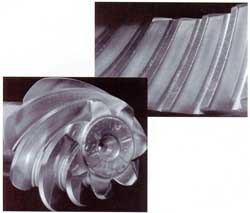 |
| The gears protected by AMSOIL 75W-90 Synthetic gear Oil showed little or no rippling, ridging, pitting or deposits following the L-37 High Torque Axle Test. |
Test Conditions
The L-37 High Torque Axle Test is used to evaluate a gear
lubricant's load-carrying, wear and extreme pressure characteristics
in hypoid gears operating under both high-speed/low-torque and
low-speed/high-torque conditions. A Dana Model 60 hypoid gear axle
is used with either coated or uncoated drive gear and pinion to
drive two dynamometers from an eight-cylinder, 5.7-liter gasoline
engine. With the axle filled with the test lubricant, the
high-speed/low-torque test is performed for 100 minutes, with the
gears visually assessed afterwards. Next, the low-speed/high-torque
test is run for 24 hours, followed by a thorough inspection of the
gears. Performance relative to API GL-5 and MIL-PRF-2105E
specifications is assessed based on tooth surface rippling, ridging,
pitting and wear, deposits and discoloration.
Test Results
Testing on AMSOIL 75W-90 Synthetic Gear Oil was conducted using
uncoated gear and pinion. The AMSOIL lubricant passed on all counts
and showed little to no rippling, ridging, pitting or deposits,
indicating that AMSOIL 75W-90 provides superior protection and
performance under extreme pressure conditions.
L-42 High Speed Axle Test
Test Conditions
The L-42 High Speed Axle Test evaluates the anti-scoring
characteristics of a gear lubricant operating under high-speed and
shock-loading conditions. A Spicer Model 44-1 hypoid gear axle is
driven by a 5.7 liter, V8 gasoline engine with a four-speed truck
transmission and two high-inertia dynamometers and hard accelerated
to 100 mph. The axle is periodically shock-loaded through a
dynamometer to simulate high shock-loading conditions. The axle is
accelerated through the gears to 1,050 r/min and decelerated to 530
r/min. This cycle is repeated five times, followed by 10 shock
loadings. In order to meet API GL-5 and MIL-PRF-2105E gear oil
specifications, scoring must be equal to or better than gears tested
with a reference oil.
|
Test Results
|
|||||||||||||
| The gears protected by AMSOIL 75W-90 Synthetic gear Oil showed little to no scoring following the L-42 High Speed Axle Test. | |||||||||||||
Report Problems to Webmaster
